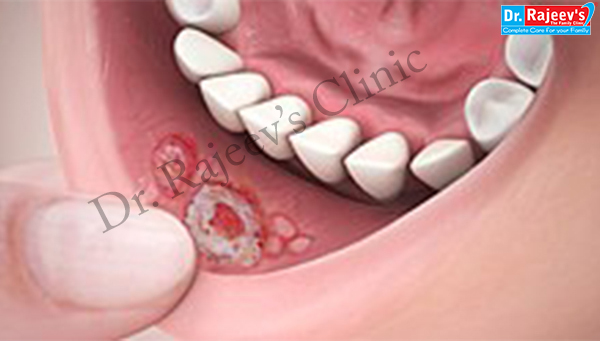

Stomatitis,is a general term for an inflamed and sore mouth, that can disrupt a person's ability to eat, talk, and sleep. Stomatitis can occur anywhere in the mouth, including inside of the cheeks, gums, tongue, lips, and palate.

There are several varieties of this stomatitis: catarrhal, pathos , ulcerative, herpetic, parasitic or thrush.
There are two main types of stomatitis:
Canker sores usually develop on the inside of the lips or cheek.These are also known as aphthous ulcers and are part of the most common cause of stomatitis. The sores are pale white or yellowish in color with a red outer ring.
Canker sores can develop singly or in a cluster and usually occur on the inside of the lips or cheek, or on the tongue.
Canker sores lead to acute, temporary pain. In minor cases, which are the most usual, the ulcers heal within 4-14 days. In more severe cases, which account for about 1 in 10 of all cases of stomatitis, the sores can last up to 6 weeks.
Cold sores are small, painful, fluid-filled sores that usually occur on or around the lips near the edge of the mouth. Caused by the herpes virus (HSV), the condition is also known as herpes stomatitis.
A person may experience a tingling or burning sensation before the sore appears, as well as tenderness. Cold sores dry up and crust over with a yellow-colored scab.
Cold sores tend to last for around 5-7 days and can keep coming back. They are also very contagious.
Stomatitis can be broken down into different categories, depending on which area of the mouth is affected:
Stomatitis can be caused by a variety of different factors, which may overlap with each other at the same time. Often it will be due to injury, infection, allergy, or skin disease.
Biting the inside of the cheek or lip can cause stomatitis to occur.
The most common causes are:
Stomatitis often results in pain, stinging, and soreness. Each person may experience different symptoms. These can include:
 Patient must be asked to observed strict cleanliness with respect to the oral cavity after every meal or after eating. This will prevent the formation of white patches. Use sterile gauze or a very soft toothbrush to rub of the white patches and apply a mixture and paste of glycerin with borax powder for its antiseptic effect. Generally mothers tend a reefed the baby with the left over milk in the feeding bottle after a while. This habit should be discouraged.
Patient must be asked to observed strict cleanliness with respect to the oral cavity after every meal or after eating. This will prevent the formation of white patches. Use sterile gauze or a very soft toothbrush to rub of the white patches and apply a mixture and paste of glycerin with borax powder for its antiseptic effect. Generally mothers tend a reefed the baby with the left over milk in the feeding bottle after a while. This habit should be discouraged.
BORAX : Useful for stomatitis with inflammation of the mucous membrane of the mouth and the tongue which bleeds easily.Very useful in aphthous stomatitis.Given when ulcer bleed on attempting to eat or on touch, it is a white fungus like growth. Given when the mouth is hot and the mucous membrance around these aphthae bleeds easily.Recommended when stools are usually green and soft, and always contain mucous.
Kalium chloricum : Useful for stomatitis for scorbutic and spongy gums that are soft, bleed easily and have foul breath. Given when it look very red and like fire, with gray based ulcers.Very useful for stomatitis which is pathos and gangrenous.
MERC SOL : Indicated for stomatitis when the whole mouth is moist.There is very thick and flabby tongue coated with a dirty yellow-white coating.There is an offensive breath. Given when the gems ulcerate and become spongy, recede and bleed easily with excessive salivation.
ACID NITRIC : Useful for stomatitis when tongue is red, glazed and mapped. Given when saliva is acrid and there is pricking pain in the mouth.Given when apathae are white and pale.
ARSENIC ALBUM : Useful for stomatitius with livid, bleedings gums.There is blisters form at the edges of the gum. Useful for apathae with foetor oris.There is ulceration in the mouth with marked burning and dryness. Sore lips covered with brown smile.Useful for burning which is very intense accompaised by restlessness- compelling motion in spite of weakness.
RL-36